How the US government sold the Peace Corps to the American public
Thanks for the ‘heads up’ from Dan Campbell (El Salvador 1974-77)
School of Communications
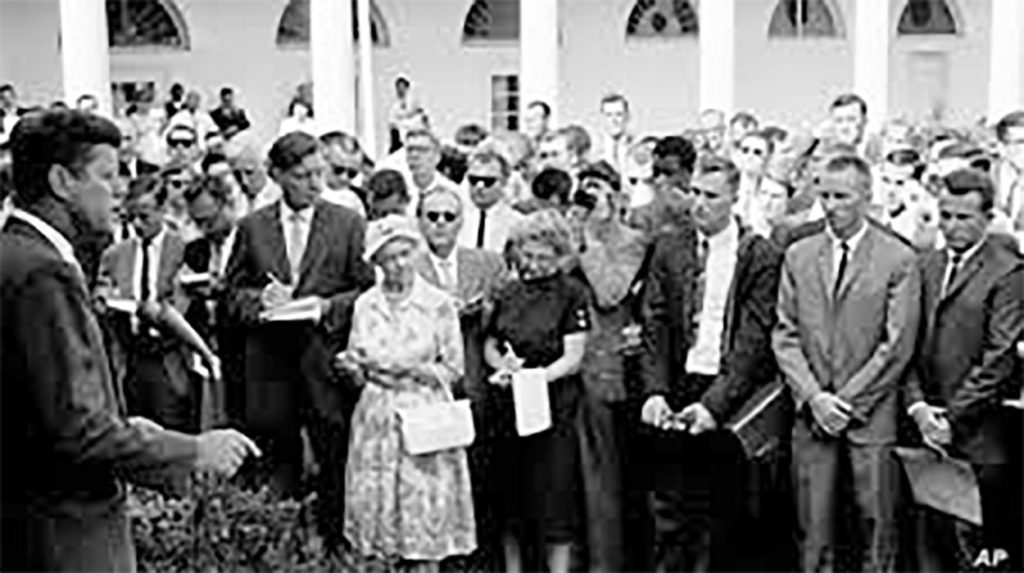
The Peace Corps, a service organization run by the U.S. government that dispatches volunteers to foreign countries, is on hold because of the coronavirus pandemic. For the first time in its nearly 60-year history, none of its volunteers is stationed anywhere.
To many Americans, the Peace Corps represents the best of American generosity abroad. That’s in line with its stated mission to promote world peace and friendship.
But having researched the Peace Corps’ backstory while studying the messages in its early advertising, I see this pause as a chance to learn more about how it came to symbolize U.S. goodwill abroad in many Americans’ minds. I’ve learned how American perceptions of the agency were shaped by ads promising heroic adventures to the volunteers who signed up.
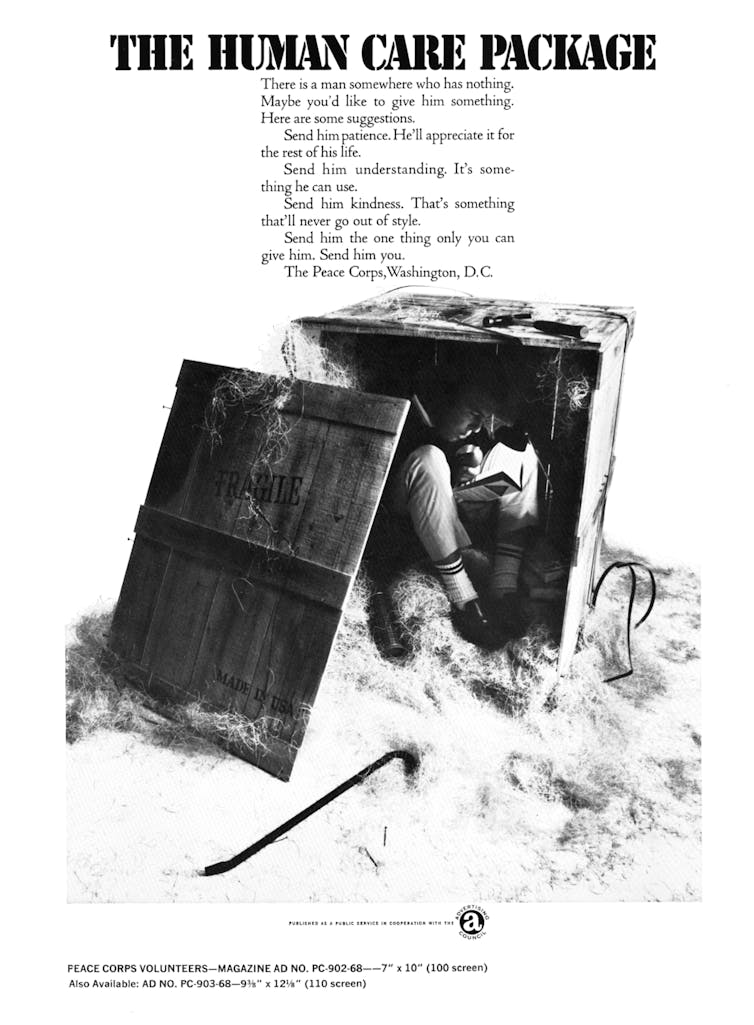
New frontiers
In an academic article I wrote about the publicity campaign for the Peace Corps in the first decade of its existence, I explained that Peace Corps advertising emphasized myths about heroes, adventure and the benefits of gaining worldly experience without ever mentioning the word communism. But fighting communism was among the agency’s original foreign policy purposes, according to many Peace Corps historians and other scholars.
Given the growing counterculture movement in the early 1960s, the government feared that few young Americans would be motivated to join the Peace Corps by a message that they’d be volunteering to help to fight communism. For that reason, the advertising strategy focused on promoting heroism while promising adventure and career advancement to potential recruits.
At the time of its creation, two institutional forces shaped the Peace Corps advertising campaign – the foreign policy goals of John F. Kennedy’s administration and the Ad Council, a nonprofit the advertising industry created during World War II to aid the U.S. government’s communications efforts.
Building on the image of Kennedy as a romantic superhero, as public intellectuals like the writer Norman Mailer described him at the time, the JFK administration positioned the Peace Corps as an opportunity that would help lead America into an audacious future.
The Peace Corps advertising campaign helped attract more than 14,000 American volunteers who trained or worked overseas in 57 countries from the start of the program in 1961 to November 1968. It also artfully masked one of main Kennedy’s foreign policy objectives for the program: preventing developing countries from adopting communism.
To date, more than 235,000 Peace Corps volunteers have served in 141 countries
Did you know: the Peace Corps doesn’t have an upper age limit. More experienced Americans bring a valuable set of skills and perspectives to service. #TBT
Are you ready for your second act? Explore open positions today: https://www.peacecorps.gov/apply/ #OAM19 #OlderAmericansMonth
We couldn’t think of a time better than #OlderAmericansMonth to share some of our favorite vintage PSAs. Which Peace Corps ads made an impression on you over the years?
Cold War roots
Concerns about communism dominated American culture and in the popular press and media throughout the 1950s and 1960s. America also needed to counter growing Soviet efforts to place young people from the USSR who were highly trained in local languages and customs in developing countries.
Kennedy worried that as the Third World gained independence from colonial empires, the developing countries would be vulnerable to communist influences. This posed a threat to American and European security.
As the historian Elizabeth Cobbs put it: “The Peace Corps owed its existence to the Cold War and to Kennedy’s belief that the United States had to do better in competing with Moscow for the allegiance of the newly independent countries of the Third World.”
The handbook for Peace Corps volunteers instructed them to study communism “as an ideology and as an organizational weapon.” The handbook advised that “communists are against the Peace Corps and its program,” and that the communists considered volunteers to be “spies and agents of imperialism.”
The Peace Corps also encouraged its volunteers “to answer our detractors through hard work and accomplishment” instead of engaging with them in debates.
The Ad Council sponsored the Peace Corps campaign until 1991. Earlier, it had played a key role in shaping U.S. attitudes about communism, socialism and capitalism through campaigns that promoted America’s economy as the cornerstone of American capitalism.
The council’s 1948 campaign to “Explain the American Economic System,” which ran until 1951, and its traveling exhibition called “The People’s Capitalism,” which explained the American economy to other countries, are a few examples.
The ad campaign
The Peace Corps’ earliest promotional materials never overtly raised the specter of communism. Instead a series of ads and posters called on Americans to participate in a program that would make their life more meaningful by making a difference in the world.
Those early Peace Corps ads encouraged volunteers to embark on a grand adventure that sounded like a fun extended study abroad program.
“Do you have your future mapped out?” read the copy in one 1961 print ad launching the campaign. If not, have you considered America’s exciting new Peace Corps? It’s an exciting and stimulating life, and best of all, you will be helping your own country as you help the people of other countries.“
By the end of the 1960s, the messages embedded in the individual ads appealed to youthful idealism, patriotism, a desire to see the world and the hero myth without references to the struggle against communism being waged in the Vietnam War.
In a 1968 “Human Care Package” magazine ad, a young man crouches inside a wooden box stamped “made in the USA.” The copy reads: “There is a man somewhere who has nothing … Send him the one thing only you can give him. Send him you.”
Americans in the turbulent 1960s wanted to believe that their country played a morally good role in the world. The Peace Corps program and its advertising helped convince them that this was true.

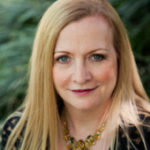
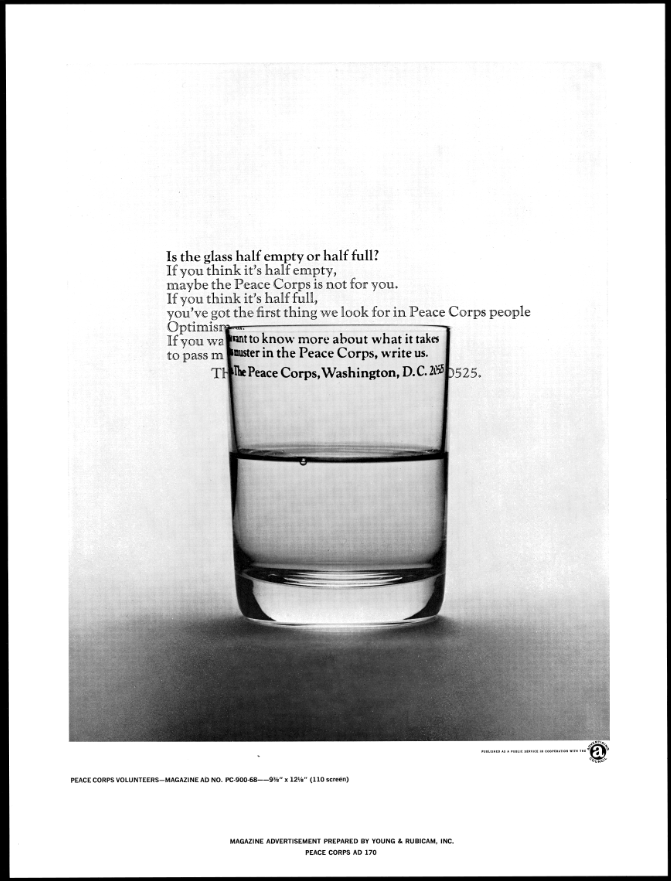
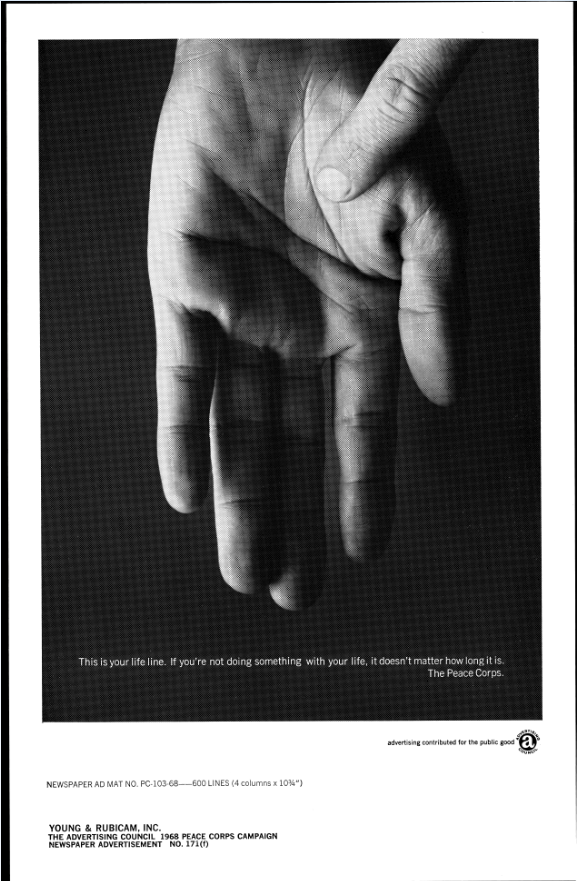
Probably nowhere was this Cold War semi-confrontation a reality more than in the earliest years of the Peace Corps in newly-independent Ghana, with Pan-Africanist Kwame Nkrumah, as president, trying to finesse a balancing act between to two centers of world affairs.
I have a bunch of first-hand stories of those memorable years, from the Geological Survey’s cointingent of Russian and E Bloc scientists; the Russian interpreters and “The Great Escape”; to simple stories of the USSR’s feeble and ineffective efforts at it’s own volunteer corps. And then the discovery that Pres Nkrumah had dumped his wife from the Western Region, to politically marry an Egyptian woman. You haven’t heard what foul language is until you heard Ghanaian women talking about THAT.
If there is interest in some of my Ghana stories, I’d be happy to write them up for the site. John Turnbull Ghana-3 Geology and Nyasaland/Malawi-2 Geology Assignment. 1963, -64, -65.
These snippets sound as though we will get to read some wonderfully interesting stories, perhaps some from a point of view not often heard. Views not previously read and amusement are what I’m looking for. Write on!
John,
I spent three years as a Volunteer in Colombia, then 5 years on PC/W staff. I cannot recall at any time that my presence was to deflect the “specter of communism’. In late 1954, then-Director Jack Vaughn visited five villages in Colombia. He wrote: “In all five, I was carried into the villages on the backs of the Indians who wanted to show me that they were in the human race. They had built a school, the first in hundreds of years; they all had a clinic for child development–the first in hundreds of years; they all had water piped in–and they done it themselves. They had made more physical progress in a couple of years than they had made in the past several hundred years. But more importantly was the attitude, the openness, the willingness to look you in the eye and tell you about who they were and what they had done, and the pride and self-respect of citizenship. All this was done by Peace Corps Volunteers. What the Spaniards and the Incas and the Western miners and the diplomats and the AID people couldn’t do in the past several hundred years, the Peace Corps had helped to do it in about three years”.
Note: no mention that they were there to deflect ‘the specter of communism’.
I think you mean 1964. The only reason I even mention it is because “Peace Corps” commentary by “academic types” is replete with errors and I would hate to see your excellent comments misused.
Dear Joanne Roll:
I appreciated your correction. Right, it was in 1964. Thank you.
i THINK I’VE LOCATED myself in this opening photo — behind the two big guys on the far right in the first row I’m behind and between them with a tie and a dark suit, white guy, and dark hair (5foot 8+inches). I remember that scene clearly now. (Those big guys in the front on the right were probably guards, I’d bet now.) After that we Ghana 1 guys and gals, white and black, went into the Oval Office singly and were photographed with Jack Kennedy. (My photo was sent to my mother Ruth and maybe one of my 4 sister, Agnes McGaha, may have it among Mycue family records and photos she had at one time — my mom age 82 died 1997. Yesterday, on ZOOM about a dozen of us –we were 50–met online for the 3rd for less than hour. I think that there are less than 40 of us left, which is amazing considering our ages (I think I am about the average and I am 83. My location seems right because I recall it was about there then.
John,
I hope you can indulge me with another comment. When on PC/W staff, I was in the Office of Public Affairs. During the period 1965-70, one of our missions was to recruit new volunteers. Our office sent mostly RPCVs into every college campus that would agree to host one of our recruiters. All PC/W staff were expected to participate with our Office in recruitment drives. These college recruitment drives went on all year long. We never felt competitive with the free services of the Ad Council. In fact, I can’t remember ever using one of their Ads in our college recruitment drives. The answer then to “how did the US Government ‘sell’ the Peace Corps to the American people” is more properly placed on the extensive efforts all year long on campus recruitment rather than on an Ad campaign. In every one of those campus drives, professors and faculty members invited our recruiters to their classes. And they encouraged their students to join the Peace Corps upon graduation.
When our new president is sworn in this coming January, we will be nearing two decades of war- twice the time of the Greek siege of Troy. It’s time to declare peace and repeal the Patriot Act which has created a police state. It’s time for the federal government to stop the yard sale of military weapons to our police, dismantle private prisons, reinstitute the former DOJ police guidelines with federal funding to aide state, county and local agencies for a return to civilian rule. It’s time to remind those who speak of “outside agitators” that we are all citizens. It’s time to reimpose post-civil war federal supervision of state elections to stamp out gerrymandering and voter suppression. It’s time to mend fences with our neighbors by tearing down those walls. Most importantly for us old folks, it’s time to concentrate on the road ahead and stop being hypnotized by the rearview mirror. That’s dangerous!
I really liked seeing the posters again. There were some items, in the Professor article, with which I really didn’t think “captured” the early days of Peace Corps. For example, this statement:
“Given the growing counterculture movement in the early 1960s, the government feared that few young Americans would be motivated to join the Peace Corps by a message that they’d be volunteering to help to fight communism.” UH?
Didn’t Professor Wendy Melillo ‘s “research” include the response to Kennedy’s middle of the night speech at U of Michigan and the incredible immediate response on the part of thousands of college students, facilitated by student Alan Guskin and his wife, Judy. This event anchors the beginning of the Peace Corps history. All of this without one assist from Madison Avenue.
I also wondered about this “fact”.
“The Peace Corps advertising campaign helped attract more than 14,000 American volunteers who trained or worked overseas in 57 countries from the start of the program in 1961 to November 1968.” Again, UH?
I went to the classic and absolutely reliable Peace Corps Chronology 1961-2010, compiled and published by RPCV author, Lawrence f. Lihosit. He listed the number of Volunteers by year. I added up the numbers from 1961 to 1968 and divided by 2, based on each Volunteer serving two years. I got 34,624 Volunteers – more or less.
I thought it best to read the whole article. Professor Melillo is an Associate Professor at American University, home of the Peace Corps Community Archives. Perhaps I had misunderstood.
However, the article is not available online until one pays $44 US for a 24 hour download. I am still in awe of Professor Kallman’s Peace Corps book which originally sold in April, hard copy $110 and Kindle almost $30. In my opinion, the mother lode for financial rewards is academia. Now, we find out!